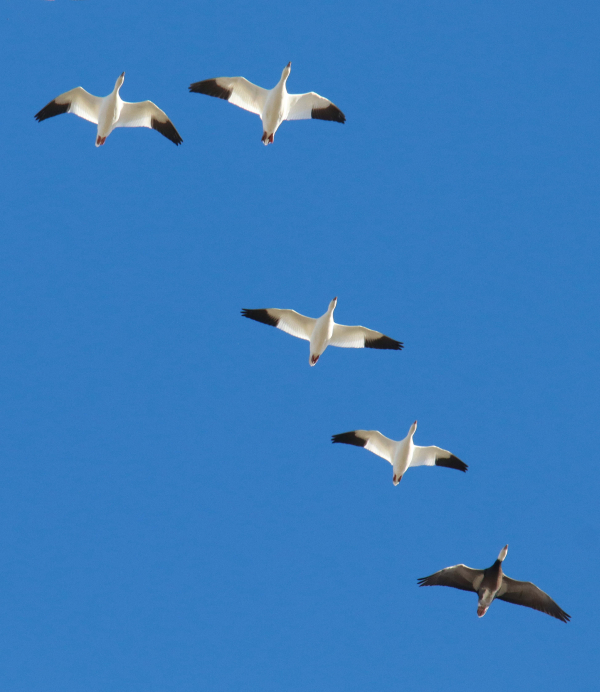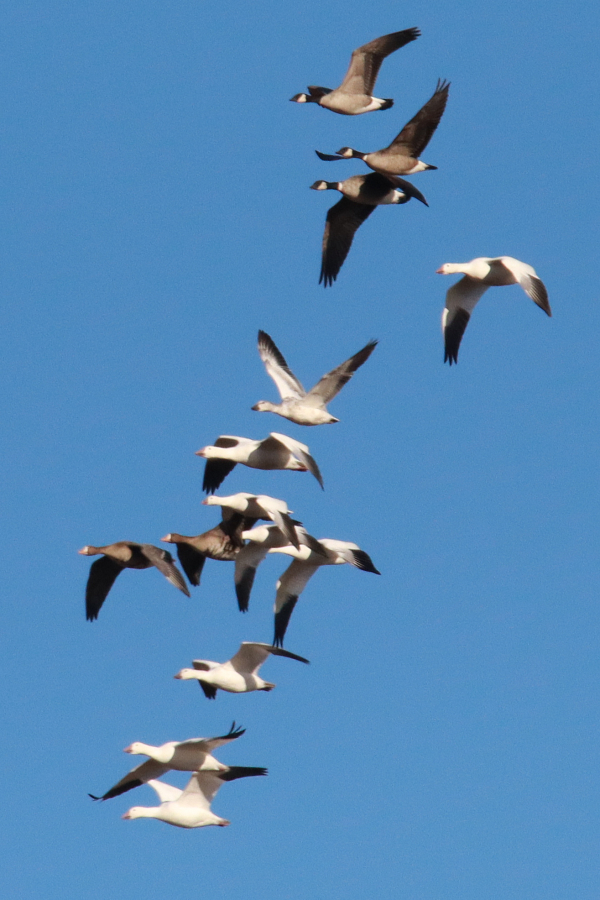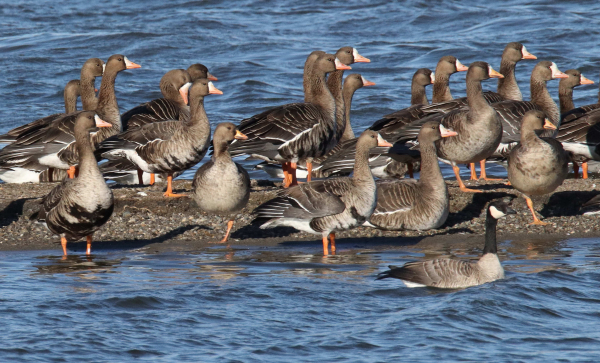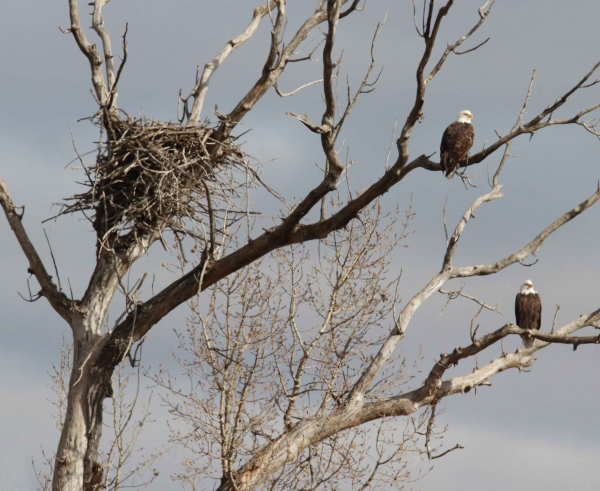
A pair of interesting sightings included seeing 5 female Hooded Mergansers separated from 5 males about 2 miles apart.

A small part of a high-flying, vocal flock of Snow Geese that flew directly over my house Monday morning.

The 4 species of Arctic-nesting geese that migrate through the area can be seen in this photo. Starting from the top, Cackling Geese, Snow Geese, and White-fronted Geese are easily recognizable, and the lone Ross’s Goose is flying to the right of the White-fronts in this photo.

Several subspecies of Canada Geese are also present in some local wetlands, although the Canada’s nest south of the Arctic region.

A lone Cackling Goose was swimming next to a regular resting location for White-fronted Geese.

It’s interesting to note that all the Bald Eagle sightings in South Dakota were associated with a nest site, including this pair at a familiar nest at Sand Lake National Wildlife Refuge.
|
Early flocks of migrating waterfowl, most notably Arctic-nesting geese and swans, continue to provide exciting birding action with big feeding flocks of Snow Geese numbering in the thousands touching down 4 miles south and 7 miles east of the office. It’s always a thrill to be close to a mega-flock as it provides surround-sound goose music with flocks of geese flying in Vs to join a goose haven on a lake or a harvested corn field. As flocks pass by to the gathering area, it’s possible to pick out a few White-fronted Geese among the many Snows, along with fewer Cackling Geese and more Ross’s Geese.
It's an exciting period that marks late fall in the best ways, and the geese will increase into the tens of thousands and hundreds of thousands before freeze-up – and that’s just in the local area; other locations within 90 minutes will attract similar build-ups of the 5 species of geese (the above-mentioned 4 species plus Canada Geese). Locally, it all began last Wednesday, when before midnight I heard a flock of Snow Geese calling as they winged high over my house on a southbound flight.
Thursday afternoon I took to the road to get an overview of how migration was progressing at potential stopover sites to the west and northwest with exciting results. The biggest flock of Snow Geese numbered at least 1,000, feeding in a harvested grain field, and there were plenty Tundra Swans at key wetlands too, including one concentration of an estimated 175. My first stop was Dean’s Lake, just 1 mile northeast of home, where I found 54 Tundra Swans, about 200 White-fronted Geese, 10 Cackling Geese, and a single blue morph Snow Goose. From there, scattered Tundra Swans numbered 23, 8, 16, 3, 8, and 2, while Snow Geese numbered approximately 220, 300, 400, and a solid 2, in addition to the aforementioned feeding flock of about 1,000 Snows.
Other geese included about 30 White-fronted Geese and 35 Canada Geese, while among the duck legions a large group of about 180 Lesser Scaup were in company with Canvasbacks and Mallards; there were 45 American Wigeons in one flock, with a couple scattered flocks of Gadwalls, and a flock of Ruddy Ducks. In the process of Thursday’s birding drive I covered the Raptor Route too, where I again observed 4 single Northern Harriers, but no other raptor species. I did see a migrating flock of 15 American Crows though.
North – South, Birding the Dakotas
Upon seeing some sunshine Saturday morning, I postponed my usual morning shower and drove south with Sand Lake Refuge in mind as a destination. But my first surprise appeared less than 4 miles south of home, where a new flock of about 500 Snow Geese with some White-fronts and Ross’s Geese mixed into the feeding mass on the edge of a newly harvested cornfield. That’s where I could take the closest looks the geese afforded this fall. It’s always fun to see the mix of white adults and blue adults – the 2 Snow Goose color morphs, plus hybrids that have varying mixes of white and blue, usually a blue-looking goose with a white belly and the usual white head. But some hybrids are more white than blue, which makes them very interesting to view.
Of course, at this time of the year, there are many family groups in the flocks, and the young white morph Snows are identified by their white-gray plumage, while the blue morph Snows are colored medium-gray with a light-blue tint. I always like to count the number of young in family groups when that’s readily notable. Snow Geese are simply wonderful birds with exciting volumes of goose music, and it’s always special to have them in my neighborhood – and Saturday was the first day Snows have appeared so close this fall. The White-fronts are equally exciting to have on hand, and their voices are the least “goose-like,” but a favorite call of the wild for me. Later, when I returned home, I heard a small group of White-fronts as I emerged from my car, and I quickly located their low flight a quarter-mile south.
I observed 6 Tundra Swans a few miles farther south, but looking back on my birding drive, there were very few swans, just 2 more in North Dakota and groups of 4 and 3 in South Dakota. Adult Bald Eagles were scattered along the way as expected, numbering 1 pair and 1 single adult in NoDak, with 2 pairs and 1 lone adult south of the border. It’s interesting to note that all the South Dakota eagles were associated with a nest – either perched in close proximity to a nest, or in the case of the lone eagle, flying to the nest and landing there.
As I drove highways up to 25 miles north of the border that divides the Dakotas, and 30 miles south of the border, the difference in the landscape was quite obvious in that many trees still had golden-colored leaves, and the birds mirrored a similar difference in species observed, primarily among shorebirds and waterfowl. North Dakota shorebirds were limited to Greater Yellowlegs in groups of 3 and 1, but south of the border I counted groups of Wilson’s Snipe numbering 9, 20, and 5, along with 9 and 1 Lesser Yellowlegs, a late flock of 11 Killdeer, 5 American Avocets, and about 70 Long-billed Dowitchers. Other sightings restricted to northern South Dakota were 10 White Pelicans, 1 Western Meadowlark, and 22 American Robins.
In the waterfowl groups, North Dakota sightings included 16, 2, and 6 Tundra Swans, Hooded Mergansers in flocks of 5 females separated from 5 males by 2 miles, along with flocks of Gadwalls, Mallards, Lesser Scaup, and American Wigeons. And in the goose department, I observed groups of Snows (500, 60, and 150), White-fronts (17 and 1,200 with Snows and Canadas), and Canadas (40, 120, and 70). By comparison, South Dakota waterfowl sightings included Tundra Swans (3 and 4), White-fronted Geese (200 and 350), and flocks of Mallards, Northern Pintails, Green-winged Teal, and Gadwalls.
My overall impression was that more northern migrants were present in the area of southern North Dakota that I surveyed, and more lingering migrants were present in the Sand Lake area of northern South Dakota. I also checked on the Hecla Marsh area, and was surprised to see it was devoid of wading birds – ibis, egrets, and herons – and even cormorants were absent. In fact, the only wader I observed was a late Great Blue Heron 7 miles south of home. It was an especially interesting birding drive to assess the state of migration November 1st.
Feeder Times – All of last week’s birds continue to visit my feeding station at their own rates, including the male Hairy Woodpecker, at least 2 White-breasted Nuthatches, a few House Finches, and Blue Jays that are vocal daily, but rarely show (when they do, there are usually 2 or 3 at a time, but no dining yet). Monday afternoon 2 Dark-eyed Juncos visited my yard, the first in a few weeks, but I’m hoping for more migrants to appear pronto – come to Paul’s yard for free food and fresh water!
I predict the coming week will take me west to the Missouri River and east to Minnesota lakes country with some special birds along the way – before and after a blast of cold weather from Canada over the weekend. I’ll be sure to share the birding highlights with you next Wednesday, along with some photographs – and I hope your first week of November is bringing exciting birds your way too – Good Luck!
Article and Photos by Paul Konrad
Share your bird sightings and photographs at editorstbw2@gmail.com